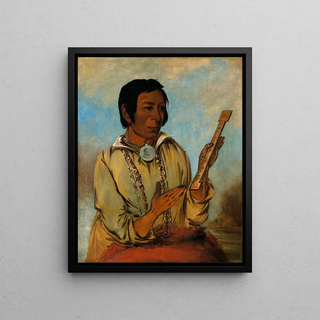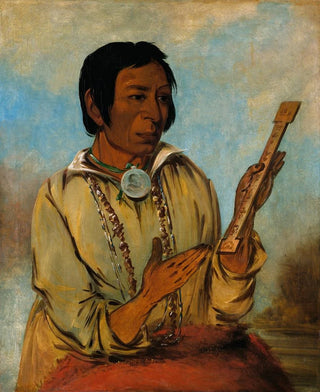Art print Mashena Elks Horns un sous-chef - George Catlin | Art print


View from behind

Frame (optional)
George Catlin's artwork "Mashena Elks Horns un sous-chef" is much more than a simple pictorial representation; it embodies a captivating encounter between art and Native American culture. As a traveling artist, Catlin dedicated his career to immortalizing North American tribes, their traditions, and ways of life. This piece, in particular, reveals the richness of a often little-known culture, while offering a window into the history of indigenous peoples. Contemplating this art print transports you to a world where every detail matters, where vibrant colors and the expressions of the characters tell a deep and emotional story.
Style and uniqueness of the work
Catlin's style is distinguished by his meticulous attention to detail and his ability to capture the essence of his subjects. In "Mashena Elks Horns un sous-chef," the artist uses earthy colors and rich textures to evoke the daily life of the Sioux, while highlighting symbolic elements such as the elk horns, which represent the strength and dignity of the character. The piece is characterized by a dynamic composition, where the sous-chef seems almost to emerge from the canvas, engaging the viewer in his universe. This immersive approach, combined with striking realism, allows the observer to feel the intensity of human emotions while immersing themselves in Native American culture.
The artist and his influence
George Catlin, born in 1796, is often regarded as one of the first artists to document Native American cultures with a respectful and curious gaze. His commitment to preserving these cultures, then endangered by colonial expansion, made him a pioneer in the field of visual anthropology. Catlin traveled across the United States, painting portraits of chiefs and members of various tribes, while collecting stories and artifacts. His work not only contributed to the understanding of indigenous peoples but also influenced many artists and writers who followed in his footsteps. By celebrating cultural diversity through his paintings, Catlin opened the

Matte finish

View from behind

Frame (optional)
George Catlin's artwork "Mashena Elks Horns un sous-chef" is much more than a simple pictorial representation; it embodies a captivating encounter between art and Native American culture. As a traveling artist, Catlin dedicated his career to immortalizing North American tribes, their traditions, and ways of life. This piece, in particular, reveals the richness of a often little-known culture, while offering a window into the history of indigenous peoples. Contemplating this art print transports you to a world where every detail matters, where vibrant colors and the expressions of the characters tell a deep and emotional story.
Style and uniqueness of the work
Catlin's style is distinguished by his meticulous attention to detail and his ability to capture the essence of his subjects. In "Mashena Elks Horns un sous-chef," the artist uses earthy colors and rich textures to evoke the daily life of the Sioux, while highlighting symbolic elements such as the elk horns, which represent the strength and dignity of the character. The piece is characterized by a dynamic composition, where the sous-chef seems almost to emerge from the canvas, engaging the viewer in his universe. This immersive approach, combined with striking realism, allows the observer to feel the intensity of human emotions while immersing themselves in Native American culture.
The artist and his influence
George Catlin, born in 1796, is often regarded as one of the first artists to document Native American cultures with a respectful and curious gaze. His commitment to preserving these cultures, then endangered by colonial expansion, made him a pioneer in the field of visual anthropology. Catlin traveled across the United States, painting portraits of chiefs and members of various tribes, while collecting stories and artifacts. His work not only contributed to the understanding of indigenous peoples but also influenced many artists and writers who followed in his footsteps. By celebrating cultural diversity through his paintings, Catlin opened the
12,34 €






